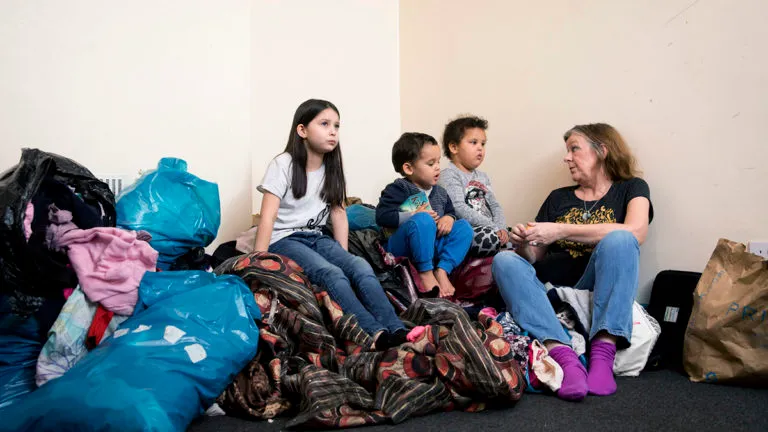A Capital in Crisis: what has caused London’s housing emergency?
Published: by Reshima Sharma

In May, Londoners will head to the ballot box to elect their next mayor. London is at the centre of this country’s housing emergency and the mayor has direct powers as well as influence to achieve much needed change. Ahead of the election, Shelter will be publishing a series of blogs on London’s deepening housing emergency and the actions that the next mayor, London councils, and national government can take to fix it.
This blog focuses on the problems London faces, before later pieces look at the solutions.
The affordability crisis
For most Londoners, the impact of the housing emergency is inescapable. A toxic combination of soaring private rents, insufficient housing benefit levels, and the disappearance of social rent housing has left too many families unable to find a genuinely affordable place to call home in London.
Low income Londoners trapped in the private rented sector feel this most acutely. Between 2008 and 2019, private rents in London shot up by a third and the average private renter spends an enormous 57% of their income on their rent.
It is hardly surprising that many question whether they can continue to afford to live in the capital: recent research by the Royal College of Nursing revealed that well over half (57%) of the nursing staff they spoke to were planning to leave London because of the extortionate cost of living. Sky-high rents contribute to this cost more than any other expense.
London’s affordability crisis has been exacerbated by dwindling housing benefit levels, which has made much of London impossible to afford for households on low incomes. Local Housing Allowance (LHA), the benefit available to private renters, was originally designed to be equivalent to the 50th percentile (cheapest 50%) of market rents and ensured that low-income private renters were not priced out of their local rental market. Over recent years, however, LHA has undergone a series of cuts and freezes.
While the government’s current policy intention is that LHA should reflect the 30th percentile of market rents in any area, this is not the case in any part of London. In fact, 69% of LHA rates in London no longer cover even the cheapest 10% of private rents across the capital. This has meant households in receipt of LHA have faced huge shortfalls between their benefits and their rent, leaving many with impossible decisions about how to make ends meet.
Shelter research found that across England nearly half (48%) of LHA recipients have had to borrow money in some way to pay their rent, leading many to accrue rent arrears and putting them at increased risk of homelessness.
A chronic lack of social housing
For those struggling to afford the ever-increasing private rents in London, social housing should be the answer. Social homes provide families with a truly affordable tenancy because rents are pegged to local incomes. Shelter’s analysis of different forms of rent tenures in London revealed the vast difference between median social rent lettings and even the cheapest market rents. While the median monthly social rent on a 2-bed property is currently £496 in London, the average lower quartile private rent for the same sized property is more than twice as expensive at £1,250.
Social rents are also much cheaper than other so-called affordable tenures, such as London Affordable Rent. Looking at 2-bed properties once again, Shelter found that an average London Affordable Rent would cost £690 a month – nearly £200 more every month than an equivalent median social rent letting.
Only social rent delivery can meet the affordability needs of the private renters, workers, and homeless families at the sharpest end of London’s housing emergency. Yet despite a growing need, social homes in London have almost entirely disappeared over the past 10 years. Just 534 additional social homes were delivered in London last year – a decrease of 95% compared to 2011-12, in which more than 11,000 properties for social rent were delivered.
Homelessness rising
With rents racing ahead of wages, social housing delivery vanishing, and housing benefits no longer covering the cost of renting in London, it is sadly no surprise that homelessness and rough sleeping has been on the rise.
Last year, there were 243,551 households on social housing waiting lists across the city. More and more are ending up homeless, either sleeping on the streets, in their cars, overstaying their welcome on friends or families’ sofas, or placed by councils in awful quality, insecure ‘temporary accommodation’.
Between 2010 and 2018, the number of Londoners sleeping rough on any given night more than tripled. And of the 163,100 Londoners estimated to be homeless and living in temporary accommodation at the start of last year, more than half were children.
London is in desperate need of genuinely affordable homes, but until social housing receives proper investment, this need will only grow. That will mean more children growing up in B&Bs. More families cutting back on food just to afford the rent. And more key workers leaving the capital because they can no longer afford to call London home.
That’s why Shelter is calling on the next mayor to reboot social housebuilding in the capital and make it their top priority to ensure London is affordable to everyone that wants and needs to call this city home.
Today Shelter has published A Capital in Crisis, which reveals London’s housing emergency and outlines key recommendations to the next mayor and government. Read the full report here and sign up here to join our campaign today. Help us call on all mayoral candidates to commit to using their power and influence to secure the social homes London urgently needs.